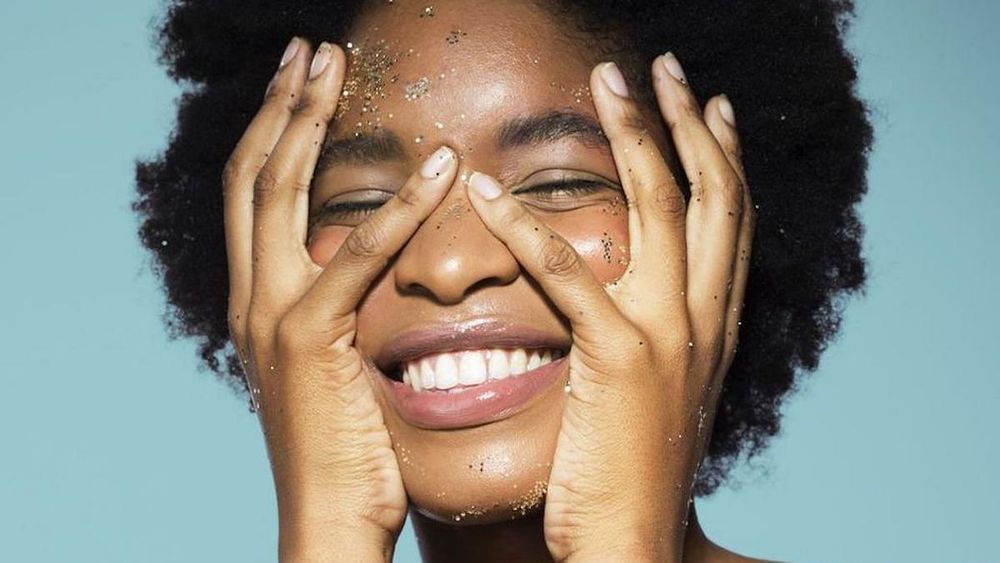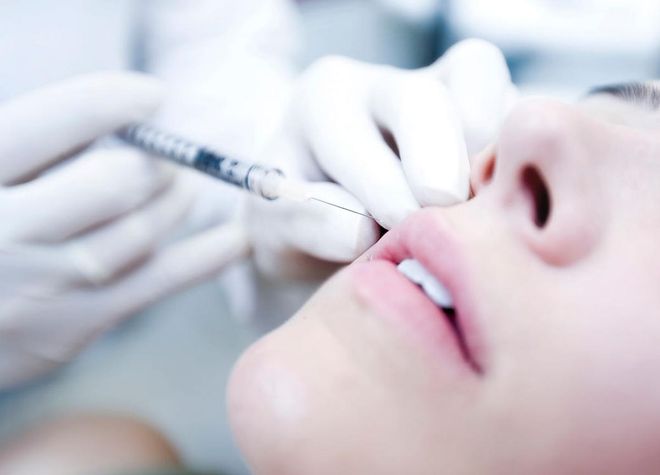How To Get Rid Of Laugh Lines With Five Expert-Approved Tips
Dermatologist and plastic surgeon-approved tips for smoothing those deep creases around your mouth


Photo: Jonathan Knowles/Getty Images
Laugh lines are no laughing matter if you prefer your skin to be wrinkle-free. We spoke with dermatologists Cindy Yoon-Soon Bae and Morgan Rabach, plastic surgeon Dr. David Shafer, and aesthetician Yolanda Mata to break down everything we need to know about laugh lines: What are they? Are they really formed from laughing? How can you get rid of laugh lines?
WHAT ARE LAUGH LINES? WHAT CAUSES THEM?
Laugh lines are the vertical lines that extend from the sides of the nose and curve around the mouth and sometimes extend to the chin. You're not the only one that has them—these lines are incredibly common. Shafer says there are two types of laugh lines: the nasolabial crease and the nasolabial fold. He explains that the nasolabial crease is the line you see between the upper lip and cheek and the fold is the skin or tissue that hangs over that crease. Both types develop over time from aging and other lifestyle factors.
“If you look back in your high school yearbook, probably half the people have a nasolabial crease—so it is not necessarily a sign of aging,” says Shafer. “People develop deeper creases with age, weight gain, and with recession of the dentition or dental problems; the teeth are no longer supporting the overlying tissue which makes the crease deeper.”
Related article: How To Get Rid Of Forehead Wrinkles (Yes, It’s Possible)
Finding a treatment to reduce their appearance depends on whether they are dynamic wrinkles (wrinkles you see with movement) or static wrinkles (wrinkles you still see when your face doesn’t move). “We want to prevent the static wrinkles because they can become more difficult to treat over time,” says Bae. “Laugh lines seen when you are laughing are dynamic wrinkles, and when you are not laughing but are still there are considered static. They are pretty common as we use the muscles around our eyes and lips all the time when blinking, smiling, animating, etc.”
Related article: The 8 Best Retinol Creams You Can Get Right Now
THE CASE FOR FILLERS
All three doctors say the most common treatment for laugh lines around the mouth are fillers, but Shafer stresses the importance of finding a board-certified expert who understands the nuances of facial anatomy. “If too much filler is placed in the wrinkle, you may be very smooth but you may also look puffy—this can look odd around the mouth,” he says. “That is why my approach is conservative. We may do one syringe and let it settle in and then re-evaluate in a week or so to see the patient's response and to decide on further treatment.”
Rabach likes fillers because the line-plumping results are almost immediate. “Fillers are made up of hyaluronic acid, a naturally occurring sugar molecule found under the skin,” she says. “Unlike Botox which takes roughly a week to kick in, the improvement with fillers is seen immediately.”
Related article: BAZAAR Beauty Awards 2020: The Best Moisturisers That Hydrate Your Skin
THE CASE FOR BOTOX
When we smile and laugh, our mouth isn’t the only part of our face that moves. Our eyes become animated and creases form as we move those muscles. To smooth out the laugh lines that appear near our eyes, all three doctors suggest going the Botox route. “Over time, it’s like un-crinkling a wrinkled piece of paper, “ says Bae. “It’s the same mechanism of action when used in other parts of the face.”
Related article: Can Botox Really Stop Migraines?

Photo: Getty Images
Rabach says she commonly uses Botox in the upper region of the face between the eyebrows, the forehead, and around the eyes. You will start to see results after a week and the line-smoothing lasts for about three to six months, depending on how quickly you metabolize Botox.
CAN YOU FIX LAUGH LINES WITHOUT NEEDLES?
While exfoliation doesn’t outright reduce the appearance of laugh lines, it inadvertently helps smooth skin overall. Bae encourages daily gentle exfoliation with a cleanser containing physical or chemical exfoliants or any topical product with alpha hydroxy acids. Shafer agrees, suggesting products such as the Skinbetter AlphaRet Exfoliating Peel Pads that contain glycolic, lactic, and salicylic acid.
Mata, a Tatcha ambassador known for her YoliGlo facial and lymphatic massage, recommends reacquainting yourself with your facial muscles; just remember to use plenty of product so you don't needlessly stretch out your skin. "You always want to massage the skin up—never down—to lift the face," she says. "[A] massage technique I love to use around the mouth and jaw is creating fists with both hands, placing them at the corners of each side of the mouth, and then gliding them upwards with moderate pressure along the cheekbones until you reach your temples. It will help lift your mouth but also your cheeks, and the pressure applied on your temples will help with any headaches or stress you might be holding in your face."
Know that massage or exfoliation are holistic routes that perk up your face overall, rather than quickly targeting specific lines. "Regardless of the technique, the lines won’t fully go away—they’re your emotion lines—but consistent massage will help keep your skin and facial muscles taut," Mata adds.
THE BEST SKIN CARE INGREDIENTS FOR LAUGH LINES
You can also reduce the appearance of laugh lines through your skin care routine. Look for products containing ingredients like retinol or vitamin c that promote collagen production. Shafer suggests SkinMedica TNS Essential Serum or Senté Dermal Repair Cream, as both work at the cellular level to enhance collagen and dermal repair within the skin. Bae agrees and says to look to retinoids to help prevent laugh lines around the eyes.
There are alternatives if you do have skin too sensitive for retinol, which can be common around the mouth; Mata compares it to the delicate eye area. "Look for gentler retinol alternatives (such as lactic acid) that will exfoliate without causing redness or sensitivity," she explains. "Also using a daily SPF (chemical or physical) will help prevent sun damage."
WHAT LIFESTYLE FACTORS CAUSE LAUGH LINES?

Photo: Getty Images
There are plenty of ways you can reduce the formation of deep wrinkles through small changes in your day-to-day life. Rabach says to start with good habits such as getting enough sleep at night, drinking in moderation, and staying hydrated to keep skin healthy. Bae stresses the importance of using sunscreen everyday. “Daily sunscreen can help preserve your natural collagen and help prevent worsening lines,” she says.
Last, all three doctors cite smoking as one of those external causes that can cause laugh lines around the mouth to become more visible. Consider it another reason to put down that cigarette and JUUL for the sake of your overall health.
The article originally appeared on Harper’s BAZAAR US